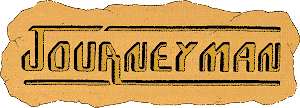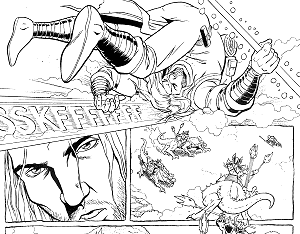Journeyman

 “It all started with Star Wars“.
“It all started with Star Wars“.
So begins the text page at the back of issue #1.
No kidding. {smile}
It’s easy to see a dozen or more elements of this series that were inspired by Lucas’ movies, from the energy staff the hero carries, to the desert world on which he lives, to the variety of alien creatures he encounters. And the story - by McKinney’s acknowledgement - is cut from the same heroic-epic cloth as that of the young Jedi. But fortunately, it only started with Star Wars. McKinney brings his own talents to the (drawing) table as well.
 Foremost among those skills is his visual storytelling. The first word of intelligible dialogue doesn’t appear until page 11, leaving his pictures to set the whole scene, to establish the mood, and to tell the story. Which they do quite well.
Foremost among those skills is his visual storytelling. The first word of intelligible dialogue doesn’t appear until page 11, leaving his pictures to set the whole scene, to establish the mood, and to tell the story. Which they do quite well.
The stage is set by a sequence of panels showing a hot, technologically-advance, but barren world in which life struggles to hang on. And that’s just in the first half of the page. The mood is established by the silence itself. And the action is described incredibly well. Once the stage is set, we get a fight scene, of which comics have had more than enough. But it’s far more imaginative than two guys trading punches; it’s a several various aliens combating with equally alien weapons. Once in a while, it’s not quite clear what happened, but most of the time the action is illustrated well enough that one could easily use these pages to choreograph it for filming.
 So it comes as no surprise to me to learn that McKinney is an animator and professional storyboard artist. But these are no mere cartoons or sketches. He has a great facility for laying out a page, formating a panel, posing a figure, and both clothing and rendering it and the scenery. Granted, setting a scene in a desert offers plenty of opportunity to take shortcuts on the backgrounds (and he appropriately leaves them out altogether when they’d detract from following the foreground action) but he renders them believably with nice texture, and makes good use of them as sets (and not just backdrops). And I can’t emphasise enough that he shows more awareness of how to draw people in a single page than many “hot” artists have shown in their whole careers. (And in this case, “people” includes non-human types as well.)
So it comes as no surprise to me to learn that McKinney is an animator and professional storyboard artist. But these are no mere cartoons or sketches. He has a great facility for laying out a page, formating a panel, posing a figure, and both clothing and rendering it and the scenery. Granted, setting a scene in a desert offers plenty of opportunity to take shortcuts on the backgrounds (and he appropriately leaves them out altogether when they’d detract from following the foreground action) but he renders them believably with nice texture, and makes good use of them as sets (and not just backdrops). And I can’t emphasise enough that he shows more awareness of how to draw people in a single page than many “hot” artists have shown in their whole careers. (And in this case, “people” includes non-human types as well.)
If it seems I’m focusing more on the art than the story, there’s a reason for that. Part of it is the fact that I know how difficult this kind of art is and I don’t see enough of it to satisfy me. The other part of it is that story is somewhat formulaic, though it’s a rather classic formula, and it’s well executed. And it’s not formulaic to the point of being predictable, just… not often surprising.
Another thing that Journeyman shares with Star Wars is the storytelling structure. This limited series, taken as a whole, tells a complete story, and it’s a fairly satisfying one. But it definitely leaves certain things unresolved for a sequel (and there’s even plenty of room for a prequel). In today’s uncertain comics market, this is a good strategy, since one - creator or reader - can never be sure that anything beyond the current mini-series will ever get a chance to see the light of day. I can’t say whether the market will call for “episode two” of this series, but I’d be more than happy to see it happen.
